The Intel Core i3-7350K (60W) Review: Almost a Core i7-2600K
by Ian Cutress on February 3, 2017 8:00 AM ESTProfessional Performance: Windows
Agisoft Photoscan – 2D to 3D Image Manipulation: link
Agisoft Photoscan creates 3D models from 2D images, a process which is very computationally expensive. The algorithm is split into four distinct phases, and different phases of the model reconstruction require either fast memory, fast IPC, more cores, or even OpenCL compute devices to hand. Agisoft supplied us with a special version of the software to script the process, where we take 50 images of a stately home and convert it into a medium quality model. This benchmark typically takes around 15-20 minutes on a high-end PC on the CPU alone, with GPUs reducing the time.
Here we report the overall time to complete the test – sub-test results can be found in Bench.
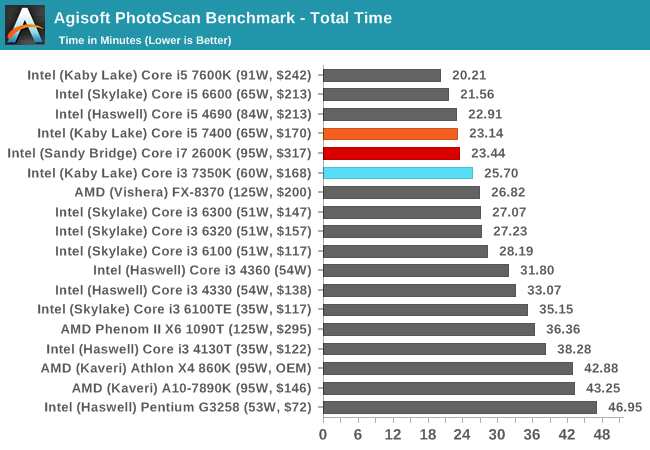
Photoscan is a mix of single and multi-threaded segments, but overall the extra cores in the i5/i7 beat the Core i3, but not by much.
Cinebench R15
Cinebench is a benchmark based around Cinema 4D, and is fairly well known among enthusiasts for stressing the CPU for a provided workload. Results are given as a score, where higher is better.
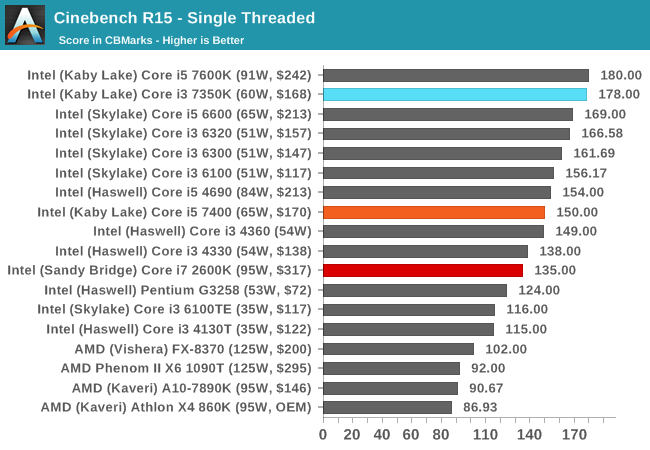
All the Kaby Lake processors seem to do well in CB15 single threaded performance, given that all the K-processors can reach 4.2 GHz or higher one way or another. Nonetheless, the age of the Core i7-2600K is showing here.
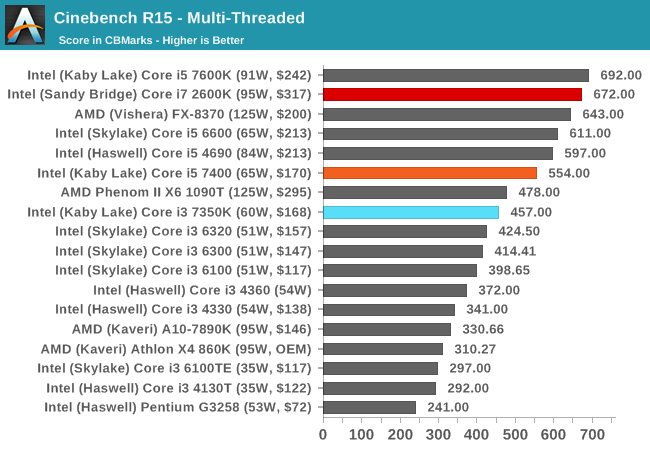
Turning the tables with actual cores, and the Core i7-2600K gets a significant leg up here. The Core i5 also sits above the Core i3.
HandBrake v0.9.9: link
For HandBrake, we take two videos (a 2h20 640x266 DVD rip and a 10min double UHD 3840x4320 animation short) and convert them to x264 format in an MP4 container. Results are given in terms of the frames per second processed, and HandBrake uses as many threads as possible.
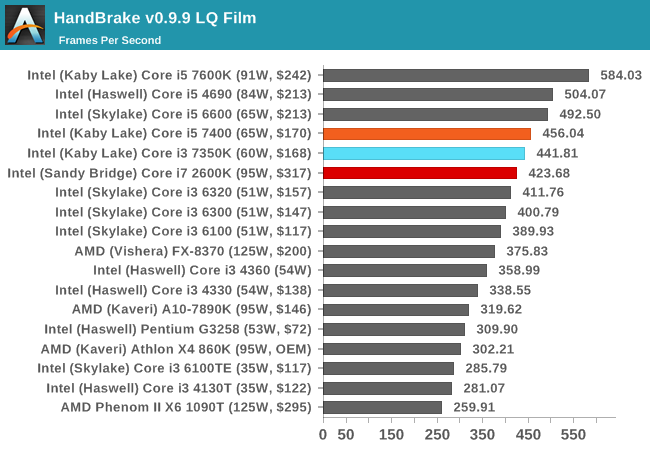

For video conversion, having small frames puts all three CPUs in a similar spot. But ramp up the frame size and we see the Kaby Lake i5 pull ahead due to IPC and instructions. The Core i3 has enough oomph to match the extra threads on the Core i7-2600K though.
Hybrid x265
Hybrid is a new benchmark, where we take a 4K 1500 frame video and convert it into an x265 format without audio. Results are given in frames per second.
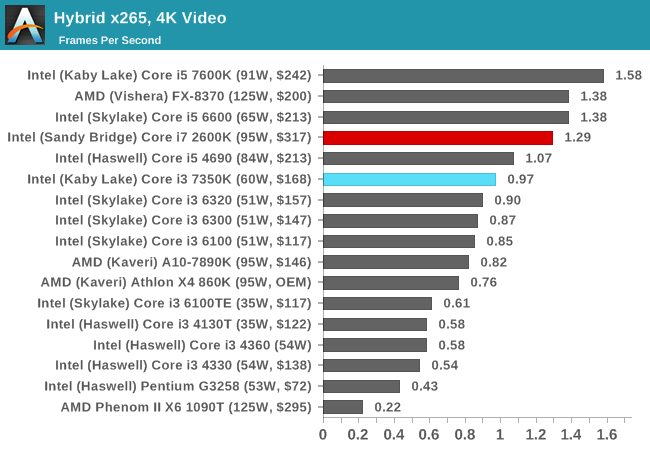
With a different video conversion tool and render, the extra cores and threads of the Core i7 is more than enough to give it a 30% advantage over the Core i3-7350K. It makes me wonder if another +30% frequency would help the Core i3.










186 Comments
View All Comments
forgot2yield28 - Sunday, February 5, 2017 - link
Agreed, the timing of the first ever i3 K variant just ahead of Ryzen seems more than just coincidental. Intel seems to be arguing that for value minded users, the IPC and high clocks will make this a better prospect that Ryzen's many-core and likely somewhat lower IPC. That's not new, what is new is that little K on the end meant to capture that market segment of users on a budget who still want the fun of overclocking. Before, the logic was always that intel wouldn't release an i3 K because it would canabalize i5 sales. Now they seem to be proactively guarding a piece of market share that would pick an overclockabe Ryzen chip instead of an i5. Competition is a wonderful thing!futurepastnow - Sunday, February 12, 2017 - link
"I'd say they are preemptively stacking the product deck prior to the release of AMD Ryzen"Yep, Ryzen will also launch with its high-end parts first- AMD's competitiveness will not filter down to low-end parts until 2h16. Until 2C4T Ryzen parts appear, Intel will still have a monopoly on good cheap processors so the more they can sell in that time, the better, for them.
futurepastnow - Sunday, February 12, 2017 - link
I meant 2h17 lol, I write the date a dozen times a day and still get it wrong.zeeBomb - Friday, February 3, 2017 - link
Hmm. What should I get instead of this then around the price range or cheaper?CaedenV - Friday, February 3, 2017 - link
how about a non-k i3?I mean look at the charts, they keep up just fine. Sure, you don't get overclocking capability, but you also get to save money by not needing a custom cooler ($30-50), or a z-series motherboard ($30-150), and the chips themselves are cheaper ($30-50). That saves you some $90+ on your build right there, while offering most of the performance. Either pocket the money, or spend it on a good SSD or better GPU.
stardude82 - Friday, February 3, 2017 - link
G4560... $64. Widely available now. Preforms just below a i3-6100/i5-2500 above Haswell i3s.Alexvrb - Friday, February 3, 2017 - link
If you want to go cheaper, see CaedenV's post below. If you're thinking about staying in roughly the same price range, get an entry-level i5. Something like a i5-7400. The cost of the processor itself is higher, but the total platform price will be around the same because of cost-savings elsewhere, like Caeden listed for the i3 non-K. You won't need to worry about overclocking so no need for upgraded cooling, and no need for an overclock-friendly board.CaedenV - Friday, February 3, 2017 - link
The i3 available back in the day suffered from quite a few things at the time, and had rather dramatic setbacks compared to the i5 and i7 offerings of the day. Still not bad as an entry level gaming CPU... but even it would bottleneck a mid to high range GPU at the time.But today's i3 offerings are able to offer enough performance to keep up with even today's mid to high end GPUs without problem! Part of that is the move to PCIe3, part of it is efficiency making up for a lack of cores, and part of it is simply because more and more games support HT cores where that use to not be the case.
On a win10 system there is even more advantage as it is better at off-loading background processes to less used cores, so even if your game does not take advantage of HT, windows will in order to alleviate the heavily loaded 'real' cores.
I think the really amazing thing to look at in these charts are how well the non-K i3 chips do. You can save a lot of money if you can give up OC and ~2-300 MHz. a plain-jane i3 on a B or H series chipset and a single mid to high-end GPU would game fantastically compared to a high-end i7 with z-series chip. Still not amazing for content creation (though not bad for a hobbiest)... but if all you are doing is video games, office/school work, web browsing, and watching videos then it is getting harder and harder to recommend anything other than an i3.
cocochanel - Friday, February 3, 2017 - link
I don't understand most comments. If you're gaming, an extra 50$ for an i5 is nothing. A CPU is good enough for 3-4 years. How much are you going to spend on games in that time period ? Here in Canada, Battlefield 1 Premium costs about 160$. That's just one game. How many games are you going to buy ? More than a few I guess. Besides, with DX12 and Vulkan becoming mainstream API's, a quad core is must. Just get an i5 or Ryzen and forget about it.javier_machuk - Friday, February 3, 2017 - link
Am I the only one that thinks that these test should have been between the overclocked speeds of both processors? Isn't the idea behind an unlocked processor that you overclock it?